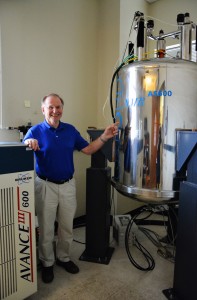OXFORD, Miss. – Known worldwide for its excellence in drug-discovery research, the University of Mississippi School of Pharmacy is installing three new nuclear magnetic resonance spectrometers to complete a suite of eight and enhance its research capabilities.
The machines, which analyze chemical and physical properties of molecules, are part of an overhaul of the school’s NMR capabilities.
“NMRs are an integral part of the drug-discovery process,” said Charles Hufford, retiring associate dean for research and graduate programs. “They are absolutely essential for the research that we do.”
The school upgraded its 600-megahertz machine in December. A 500-MHz machine and two 400-MHz machines were delivered in January to be installed in upcoming months. An additional four machines reside in various areas of the school.
Hufford facilitated the purchase of the new and updated equipment, which cost roughly $1.5 million in federal funds. The funds were approved as part of the recent construction of Thad Cochran Research Center West under Grant No. C76HF10917 from the U.S. Department of Health and Human Services.
The school has decades of experience with NMRs, having purchased its first proton-only machine in 1969. Multiple upgrades have occurred over the years, including the purchase of a superconducting 2D-NMR in 1985 and the addition of three new machines in 1995 when Thad Cochran Research Center East was built.
Maintenance, or “care and feeding,” of the machines is time-consuming, Hufford said. Most of the work involves keeping them full of liquid nitrogen and helium. These liquids allow the machines’ superconducting magnets to function properly.
Frank Wiggers, principal research and development spectroscopist, is largely responsible for these tasks.
“The new instruments will help greatly with time and cost of maintenance due to their longer hold times for both nitrogen and helium,” Wiggers said. “The new software, through automation, will also remove some of the user error. This will give the researchers better quality data in a shorter time frame.”
The machines will further help the school’s researchers by allowing them more time in general to conduct spectroscopy. It is unique for a pharmacy school to own eight NMR spectrometers, Hufford said.
“I certainly don’t know of any pharmacy school that has eight NMRs,” he said. “Many research schools have that many, but they are associated with other departments. My pharmacy colleagues at other institutions are jealous when I tell them that we will have eight.”
